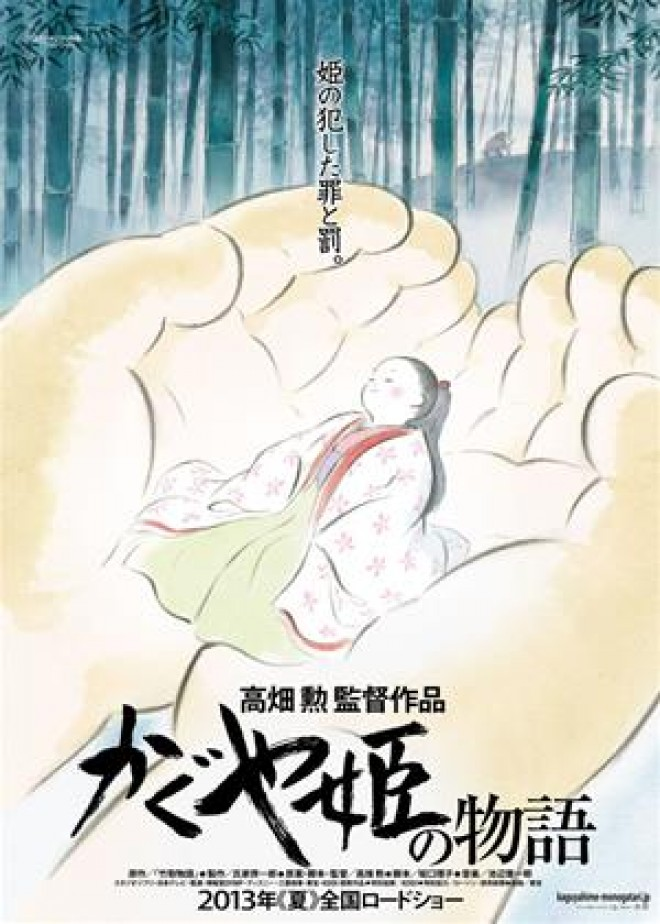“That was Heaven telling us who she’d grow into”
There is no questioning whether [Kaguyahime no monogatari] [The Tale of The Princess Kaguya] is an extraordinary work of art. The beauty of its simplistic, watercolor ink-lined drawings is a breath of fresh air within a medium of 3D-rendered characters trying so hard to not look like they’re animated when they should be embracing that fact. It is anime through a traditional lens harkening back centuries for a style to fit the age of the folktale at its back—The Tale of the Bamboo Cutter. At times crisp and fluid, at best roughly drawn charcoal strips chaotically swirling in a mass of aggression and emotion. Even juxtaposed against the rest of Studio Ghibli’s stable, Isao Takahata‘s first film in almost fifteen years stands apart.
At the end of the day this is an achievement—reason alone to get you excited to watch Princess Kaguya’s (Aki Asakura) tale unfold. However, I would be remiss not to admit how laborious its length feels, especially considering Takahata and Riko Sakaguchi‘s script tries so hard to force its titular character into a humanity with a penchant for greed and vanity that the sudden revelation of a world beyond Earth becomes too much to bear. It doesn’t derail what came before it, I did find myself empathizing with Kaguya’s strife, but it did make me wonder why I had to sit through so much for so long when the lessons learned ultimately prove disposable. Not to viewers mind you, but to the girl living them. It kind of renders it all somewhat cheap.
Granted, this insight comes from someone entrenched in Western civilization that wouldn’t know The Tale of the Bamboo Cutter from a Christian parable learned and subsequently forgot after Sunday school. I hoped for more than a morality play preaching something as ubiquitous and tired as YOLO, which seems the goal Kaguyastrives to achieve. However, when you put it in context with the story’s age (we’re talking 10th-century here) and the conservative nature built on staunch respect and what to me would be archaic rules, the idea that you can live your own life any way you see fit is a bold declaration. You don’t have to look past Kaguya’s adoptive parents (Takeo Chii‘s father Okina and Nobuko Miyamoto‘s mother Ouna) to understand. Humble, poor, and living in the woods, the thought of something more never crossed their minds.
That is, until Kaguya appeared inside a glowing bamboo shoot. At first a miniature princess caught in slumber, the girl transforms into a full-size baby before their eyes as Ouna cradles her. Growing at an alarming rate, baby becomes toddler, toddler young girl, and girl a young lady ready to be showered with the lavish gifts someone of her stature deserves. This is what Okina believes after finding a bamboo stalk full of gold and another of silken cloth. The Heavens were speaking to him, planting these seeds of a “better” life so he could build a mansion and buy his adoptive daughter the royalty of her birthright. What he didn’t think about—and this is our lesson—was whether or not Kaguya wanted it.
This first act is a delight. We meet this would-be princess frolicking in the meadows with her friend Sutemaru (Kengo Kôra): stealing fruit, climbing dirt hills, and enjoying life. Once Okina derails it all to whisk she and his wife to the capital, things get a tad verbose. Kaguya’s requisite excitement at being “her majesty” is introduced as quickly as her disdain for the proper etiquette and customs that come along for the ride. Less fairy tale and more depiction of royal life’s subservience and issues of ownership, the former prevalence of pure joy is extinguished and replaced by the anguish of an existence squandered behind a prison of decadence. Even when Kaguya finds escape—with the aforementioned gorgeously charcoal hatched escape scene—she realizes it can only happen in her head.
From here she sends five suitors on wild goose chases to ensure she won’t marry, a comedy of errors leading to increasingly more tragic ends. Did we need five? I think three would have sufficed with similar effect and a reason to trim minutes. We understand her desire to return to the woods, Okina’s neglect in accepting it, and the steady progression of years bringing them farther and farther away from what mattered most. Only when she discovers the courage to do something about it does it officially appear impossible. Not only impossible but in direct opposition to what a wholly new wrinkle has in store. The girl was born in a bamboo stalk, so her future’s—and past’s for that matter—plan isn’t hard to believe. It’s simply a jarring transition.
Regardless, there are some wonderful emotive moments demanding the film be seen above the visuals themselves. The complicated relationship between Kaguya and Sutemaru keeps the hope for love alive; her realizing how her actions effect others who don’t see life on the throne as a game reveals a sorrowful guilt; and little flourishes like a small garden at the mansion mimicking the hills of her childhood add a level of nostalgia we can relate to our own youths. And whether or not Kaguya holds tight to what she’s learned—either clearly or in the recesses of her mind—everyone she touches will. That includes us. Life is more than compromises or fabricated airs constructed above our true selves. And once we find happiness, never let go.
Score: 7/10
Rating: PG | Runtime: 137 minutes | Release Date: November 23rd, 2013 (Japan)
Studio: Studio Ghibli / Toho Company / GKIDS
Director(s): Isao Takahata
Writer(s): Isao Takahata & Riko Sakaguchi / Isao Takahata (story) / Mike Jones (English version)

